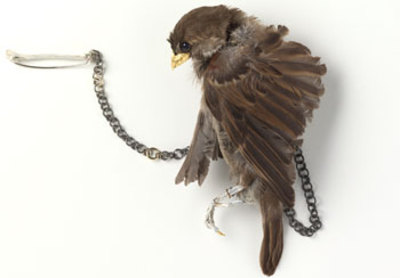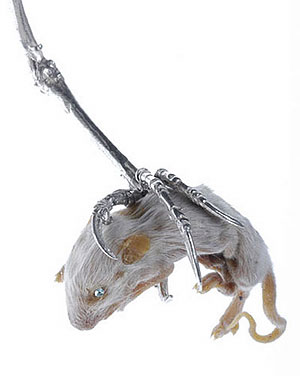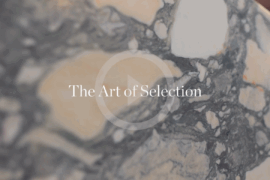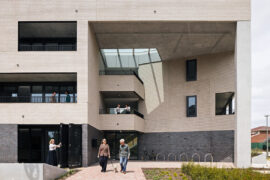Julia deVille was first attracted to taxidermy after seeing her grandmother in a fox stole. With its tail in its mouth, it was seen by deVille as a work of art. Stephen Crafti reports.
April 30th, 2008
Selected for the Primavera in 2006, Julia deVille displays a rare talent, fusing taxidermy with contemporary jewellery. Stephen Crafti was keen to find out more.
Julia deVille didn’t set out to shock people with her contemporary jewellery. It was her love for animals that led her to turning them into works of art. “One of my first pieces was a starling brooch. It had died and was on the side of a road,” says deVille, who was taught by Rudy Mineur,a taxidermist with decades of experience under his belt.
deVille’s mouse brooches, titled ‘gun club’, are confronting. Decapitated and stuffed, her mouse heads beam up at you with with diamond studded eyes. As disturbing are her ‘prey’ brooches, featuring a silver bird’s claw holding a mouse. Then there are deVille’s relatively tame skulls and beads, made from jet. “They weren’t created to shock people…I don’t believe in animal cruelty. These animals have died and my jewellery is intended to be a celebration of their life,” says deVille, who raised eyebrows displaying a stillborn kitten in one exhibition. “The kitten was a perfect three-dimensional representation.”
While deVille’s brooches, earrings and bracelets are for those who appreciate challenging jewellery, they also draw an audience with respect for history. deVille’s ‘Memento Mori’ jewellery (Latin for ‘remember you must die’) captures the religious fever of sixteenth century Europe. “There was a terrible plague at the time and death was integral to people’s lives.”
Later influences have come from the Victorian period, when death was approached in quite a different way. “Dying was more about grieving rather than looking at one’s mortality,” says deVille, who uses materials like jet, silver and black rhodium to create her Victorian style jewellery. Even a lock of human hair is transformed into an earring, complete with silver clasp.
deVille has certainly made a name for herself in the relatively short time she has been working as a jeweller. Many leading jewellery stores carry her work, including e.g.etal in Melbourne and L’Eclaireur, a chain of boutiques in Paris. She was also among a handful of young emerging artists featured at the Primavera, held at the Contemporary Art Gallery in Sydney in 2006.
“Julia’s work is quite confronting and captivating at the same time. She’s true to her concepts,” says Ali Limb, jeweller and co-director of e.g.etal in Melbourne. “Her work spans fashion jewellery through to conceptual work. She’s an important figure on both levels,” says Limb, who sees her work as continually evolving. “She’s still relatively young.”
And while deVille has won over the art critics, she’s also gained the support of her mother, who, like many, was shocked at the unveiling of her daughter’s first creations. “At the start she’d say, ‘I don’t understand why you do this. But then she came along to my graduate show (Gold + Silversmithing at the Northern Melbourne Institute of TAFE). She could see everyone trying to edge near my cabinet.”
deVille’s brooches make a statement and a strong one at that. “I try and get a message across with each piece. It’s also important to show fragility with each creature displayed. It’s a sadness rather than anger,” says deVille, who was initially horrified at dissecting a dead animal. “But after you peel back the skin, it’s quite beautiful, in a scientific way”.



INDESIGN is on instagram
Follow @indesignlive
A searchable and comprehensive guide for specifying leading products and their suppliers
Keep up to date with the latest and greatest from our industry BFF's!

CDK Stone’s Natasha Stengos takes us through its Alexandria Selection Centre, where stone choice becomes a sensory experience – from curated spaces, crafted details and a colour-organised selection floor.

London-based design duo Raw Edges have joined forces with Established & Sons and Tongue & Groove to introduce Wall to Wall – a hand-stained, “living collection” that transforms parquet flooring into a canvas of colour, pattern, and possibility.

This Sustainability Summit session will raise critical questions regarding why a sustainable design approach isn’t more prevalent in the industry.

Having orchestrated some of the most Instagrammed interiors around the world, India Mahdavi brings her signature aesthetic to Ladurée Aoyama.
The internet never sleeps! Here's the stuff you might have missed

Indesign Media is aware of recent reports raising serious concerns about Australian architectural photographer Derek Swalwell.

Brett Ward, General Manager of Marketing at Brickworks, tells us how modern approaches to sustainability are intersecting with the long history of the brick.